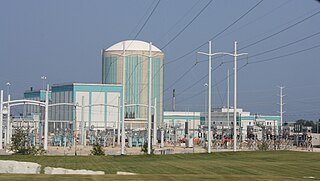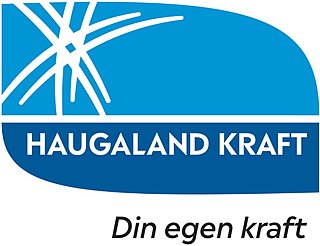| Hardeland Hydroelectric Power Station | |
|---|---|
| Official name | Hardeland kraftverk |
| Country | Norway |
| Coordinates | 59°39′27″N6°05′48″E / 59.65750°N 6.09667°E Coordinates: 59°39′27″N6°05′48″E / 59.65750°N 6.09667°E |
| Status | Operational |
| Owner(s) | Haugaland Kraft |
| Power Station | |
| Turbines | 3 × 14 MW |
| Annual generation | 123 GW·h |
Hardeland hydroelectric power station is a power plant in Etne in western Norway. The site is owned and operated by Haugaland Kraft.
The station uses water from two sets of reservoirs. Hardeland H is a 400 m vertical fall from Løkjelsvatnet, while Hardeland K uses Grindheimsvatnet, Ilsvatnet, Basurde-/Krokavatnet and Hjørnås via a 305 m fall from the Hjørnås lake.
Hardeland is connected to the grid with a 22 kV line to Litledalen. [1] The site uses three pelton wheels with 14 MW generators, and average yearly output is 123 GWh. [2]

Pumped-storage hydroelectricity (PSH), or pumped hydroelectric energy storage (PHES), is a type of hydroelectric energy storage used by electric power systems for load balancing. The method stores energy in the form of gravitational potential energy of water, pumped from a lower elevation reservoir to a higher elevation. Low-cost surplus off-peak electric power is typically used to run the pumps. During periods of high electrical demand, the stored water is released through turbines to produce electric power. Although the losses of the pumping process make the plant a net consumer of energy overall, the system increases revenue by selling more electricity during periods of peak demand, when electricity prices are highest. If the upper lake collects significant rainfall or is fed by a river then the plant may be a net energy producer in the manner of a traditional hydroelectric plant.

Hydroelectricity, or hydroelectric power, is electricity produced from hydropower. In 2020 hydropower generated one sixth of the world's electricity, almost 4500 TWh, which was more than all other renewables combined and also more than nuclear power.

The Shannon hydroelectric Scheme was a major development by the Irish Free State in the 1920s to harness the power of the River Shannon. Its product, the Ardnacrusha power plant, is a hydroelectric power station which is still producing power today and is located near Ardnacrusha within County Clare approximately 2.4 kilometres (1.5 mi) from the Limerick border. It is Ireland's largest river hydroelectric scheme and is operated on a purpose built headrace connected to the River Shannon. The plant includes fish ladders so that returning fish, such as salmon, can climb the river safely past the power station.

The Manitoba Hydro-Electric Board, operating as Manitoba Hydro, is the electric power and natural gas utility in the province of Manitoba, Canada. Founded in 1961, it is a provincial Crown Corporation, governed by the Manitoba Hydro-Electric Board and the Manitoba Hydro Act. Today the company operates 15 interconnected generating stations. It has more than 527,000 electric power customers and more than 263,000 natural gas customers. Since most of the electrical energy is provided by hydroelectric power, the utility has low electricity rates. Stations in Northern Manitoba are connected by a HVDC system, the Nelson River Bipole, to customers in the south. The internal staff are members of the Canadian Union of Public Employees Local 998 while the outside workers are members of the International Brotherhood of Electrical Workers Local 2034.

The Palo Verde Generating Station is a nuclear power plant located near Tonopah, Arizona, in western Arizona. It is located about 45 miles (72 km) due west of downtown Phoenix, Arizona, and it is located near the Gila River, which is dry save for the rainy season in late summer.

District heating is a system for distributing heat generated in a centralized location through a system of insulated pipes for residential and commercial heating requirements such as space heating and water heating. The heat is often obtained from a cogeneration plant burning fossil fuels or biomass, but heat-only boiler stations, geothermal heating, heat pumps and central solar heating are also used, as well as heat waste from factories and nuclear power electricity generation. District heating plants can provide higher efficiencies and better pollution control than localized boilers. According to some research, district heating with combined heat and power (CHPDH) is the cheapest method of cutting carbon emissions, and has one of the lowest carbon footprints of all fossil generation plants.

The Clinton Power Station is a nuclear power plant located near Clinton, Illinois, USA. The power station began commercial operation on November 24, 1987 and has a nominal net electric output of 1062 MWe. Due to inflation and cost overruns, Clinton's final construction cost was $4.25 billion, nearly 1,000% over the original budget of $430 million and seven years behind schedule.

Donald C. Cook Nuclear Plant is a nuclear power plant located just north of the city of Bridgman, Michigan which is part of Berrien County, on a 650-acre (260 ha) site 11 miles south of St. Joseph, Michigan, United States. The plant is owned by American Electric Power (AEP) and operated by Indiana Michigan Power, an AEP subsidiary. It has two nuclear reactors and is currently the company's only nuclear power plant.

The Kewaunee Power Station is a decommissioned nuclear power plant, located on a 900 acres (360 ha) plot in the town of Carlton, Wisconsin, 27 miles (43 km) southeast of Green Bay, Wisconsin in Kewaunee County, and south of the city of Kewaunee.
Løkjelsvatnet or Lykilsvatnet is a regulated lake in the municipality of Etne in Vestland county, Norway. The 4.51-square-kilometre (1.74 sq mi) lake lies about 10 kilometres (6.2 mi) east of the village of Etnesjøen. Water from the lake falls 400 metres (1,300 ft) vertically in tunnels and pipelines to the Hardeland hydroelectric power station. The site is operated by Haugaland Kraft.

Alta power station is a hydroelectric power station located on the Alta-Kautokeino River in Troms og Finnmark county, Norway. The power station is located in Alta Municipality, just north of the border with Kautokeino Municipality. It is operated by Statkraft, a Norwegian state-owned electric company, and it opened in 1987.

Peterborough Power Station is a 360MW gas-fired power station at Eastern Industry, Fengate in the city of Peterborough, Cambridgeshire in the United Kingdom. It employs around forty people.
Melkefoss power station is a hydro electric dam on the Paatsjoki river in the Sør-Varanger municipality in Finnmark, Norway.

The United Kingdom has a National Grid that covers most of mainland Great Britain and several of the surrounding islands, as well as some connectivity to other countries. The electrical sector supplies power at 50 Hz AC, and ~240 volts is supplied to consumers. In 2020 the electricity sector's grid supply came from 55% low-carbon power, 36.1% fossil fuelled power, and 8.4% imports. Renewable power is showing strong growth, while fossil fuel generator use in general and coal use in particular is shrinking, with historically dominant coal generators now mainly being run in winter due to pollution and costs, and contributed just 1.6% of the supply in 2020.
The Cårrujavrit Hydroelectric Power Station is a hydroelectric power station in the municipality of Kvænangen in Troms county, Norway. It utilizes a drop of 305 meters (1,001 ft) between its intake reservoir on the Njemenaiko River and Little Lakes, which is also the reservoir for the Kvænangsbotn Hydroelectric Power Station. Lake Tjoika serves as the reservoir for the plant and is regulated at a level between 529 m (1,736 ft) and 516 m (1,693 ft). The plant has a Francis turbine and operates at an installed capacity of 1.7 MW, with an average annual production of about 11 GWh. The plant is controlled by Kvænangen Kraftverk AS, with a 48.2% share owned by Troms Kraft.
The Kvænangsbotn Hydroelectric Power Station is a hydroelectric power station in the municipality of Kvænangen in Troms county, Norway. It utilizes a drop of 305 meters (1,001 ft) between its intake reservoir at Little Lakes and South Fjord. The reservoir is regulated at a level between 315 m (1,033 ft) and 305 m (1,001 ft). The Abo River is also utilized by the power plant. Water is supplied to the reservoir by the Småvatna, Lassajavre, and Cårrujavrit Hydroelectric Power Stations. The plant came into operation in 1965. In 1999 the company received a license to transfer water from the Brenn River, Šleađui River, and Olbmá River. The plant has a Francis turbine and operates at an installed capacity of 44 MW, with an average annual production of about 176 GWh. The plant is controlled by Kvænangen Kraftverk AS, with a 48.2% share owned by Troms Kraft.
The Lassajavre Hydroelectric Power Station is a hydroelectric power station in the municipality of Kvænangen in Troms county, Norway. The plant utilizes a drop between Lake Abo and Lake Lassa. Lake Abo is regulated at a level between 689 meters (2,260 ft) and 669 m (2,195 ft), and Lake Lassa serves as the reservoir for the Småvatna Hydroelectric Power Station. The Lassajavre plant also utilizes water from Lake Mollis and Lake Sarves. The plant came into operation in 1977. It has a Francis turbine and operates at an installed capacity of 7.2 MW, with an average annual production of about 30 GWh. The plant is controlled by Kvænangen Kraftverk AS, with a 48.2% share owned by Troms Kraft.
The Småvatna Hydroelectric Power Station is a hydroelectric power station in the municipality of Kvænangen in Troms county, Norway. The plant utilizes a 283-meter (928 ft) drop between Lake Lassa and Little Lakes. Lake Lassa is regulated at a level between 543 m (1,781 ft) and 519 m (1,703 ft), and Little Lakes serves as the reservoir for the Kvænangsbotn Hydroelectric Power Station. The Småvatna plant also utilizes water from Abo River and the Lassajavre Hydroelectric Power Station. The plant came into operation in 1969. It has a Francis turbine and operates at an installed capacity of 18.8 MW, with an average annual production of about 61 GWh. The plant is controlled by Kvænangen Kraftverk AS, with a 48.2% share owned by Troms Kraft.

Haugaland Kraft is a Norwegian power company formed in 1998 as a merger between Haugesund Energi and Karmsund Kraftlag.

Cathaleen's Fall hydroelectric power station is a hydroelectric plant located on the River Erne at Ballyshannon in County Donegal, Ireland. It is owned and operated by the ESB Group. The plant is also known as Ballyshannon.
{{cite web}}: CS1 maint: archived copy as title (link)